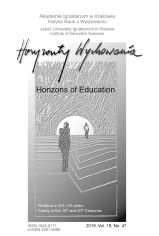Alkoholizm jako zagrożenie rodziny w świetle poradników oraz publicystyki społecznej i naukowej w Królestwie Polskim u schyłku XIX i na początku XX w.
Abstract
RESEARCH OBJECTIVE: The aim of the article is to discuss in a synthetic way knowledge, opinions and attitude toward alcoholism as a problem of family and society in guides and social journal-ism in the Kingdom of Poland during the period of “entering modernity.”
THE RESEARCH PROBLEM AND METHODS: The main research problem can be formulated as follows: in what way alcoholism as a danger to family has been problematised in analysed literature? In connection with that more detailed problems can be taken into account: what kind of factors influenced on shift of opinions of alcoholism as a problem of family and society? Which environments were said to be in danger of this pathology?
THE PROCESS OF ARGUMENTATION: After introduction to the problems three isolated questions were presented. One of them is the picture of drinking as a social and moral problem in religious literature. The other are question of medicalisation of alcoholism, existing also in the con-text of considerations about family and, finally, the presence of alcoholism shown as the reason of family and society’s degeneration in sources.
RESEARCH RESULTS: The way of presenting the alcoholism underwent crucial transfigurations. Discussion about alcoholism as a factor which threatened the family and the education of the young generation was a part of the polemics about many general questions like relationships between family and society, the role of religion and science in solving social problems, the role of the family in the conceptions of the polish statehood’s reconstruction.
CONCLUSIONS, INNOVATIONS, AND RECOMMENDATIONS: The analysis of statements concerning alcoholism as a danger to family can be helpful in further researches of the creating the picture of family and changes of its ethos on the threshold of independency.
References
II Zjazd abstynentów polskich. (1905). Zdrowie, 6, 532-534.
Alkoholizm i jego skutki moralne. (1889). Przegląd Katolicki, 49, 710-712.
Bołdyrew, A. (2008). Matka i dziecko w rodzinie polskiej.
Ewolucja modelu życia rodzinne-go w latach 1795-1918,
Warszawa: Wydawnictwo Neriton.
Bołdyrew, A. (2016). Społeczeństwo Królestwa Polskiego wobec patologii społecznych w latach 1864-1914, Łódź: Wydawnictwo Uniwersytetu Łódzkiego.
Bregman, L. (1906). O celach i zadaniach propagandy wstrzemięźliwości. Zdrowie, 4, 206-215.
Budzińska-Tylicka, J. (1909a). Higiena kobiety i kwestie społeczne z nią związane, Warsza-wa: Towarzystwo Akc. S. Orgelbranda Synów.
Budzińska-Tylicka, J. (1909b). O potomstwie alkoholików. Czystość, 2, 27-29.
Chętnik, A. (1914). Jak zwalczać pijaństwo, Zorza, 12, 177-178.
Chodecki, W. (1907). Alkohol i szkoła. Zdrowie, 6, 463-471.
Daszyńska-Golińska, Z. (1905). Pijaństwo nasz wróg, Warszawa: Wydawnictwo M. Arct.
Daszyńska-Golińska, Z. (1907). Największy wróg szczęścia kobiety. Ster, 3, 127-130.
Edman, J. (2015). Temperance and Modernity: Alcohol Consumption as a Collective Prob-lem, 1885–1913. Journal of Social History, 49, 20-52.
F. (1898). Alkoholizm. Przegląd Katolicki, 32, 481-482.
Gawin, M. (2003). Rasa i nowoczesność. Historia polskiego ruchu eugenicznego (1880-1952). Warszawa: Wydawnictwo Neriton.
Glass, J. (1907). Alkohol a prawo. Przyszłość, 4, 29-31.
Gundlach, R. (1910). Wystawa przeciwalkoholowa w Łodzi. Zwiastun Ewangeliczny, 1, 16-19.
Kłopotowski, I. (1903). Co czyni pijaństwo i litania o uproszenie wstrzemięźliwości, War-szawa: druk „Gazety Rolniczej”.
Krzewienie trzeźwości (1899). Przegląd Tygodniowy, 41, 445-446.
Mickiewicz, A. (1983). Księgi pielgrzymstwa polskiego, [w:] idem, Dzieła poetyckie, t. 2, oprac. Z. Dokurno, Warszawa: Czytelnik.
Mikoszewski, K. (1862). Kazania o pijaństwie, Warszawa: Drukarnia Józefa Ungra.
Nowodworski, M. (1893). Encyklopedia kościelna, t. XIX, Warszawa: Drukarnia Czerwiń-skiego i Spółki.
Puławski, A. (1899) Pogadanka o piciu trunków i pijaństwie: odczyt popularny, zalecony przez Warszawskie Towarzystwo Higieniczne, Warszawa:
Księgarnia G. Centnerszwera.
Skalski, S. (1910). Alkoholizm i sprawa robotnicza, Łódź: Tłocznia A. Karskiego.
Sterling, W. (1909). O samobójstwach wśród dzieci i młodzieży szkolnej. Wychowanie w Domu i Szkole, 2, 119-137.
Szubstarski, T. (1917). Sześć nauk o pijaństwie, Radom: J. Grodzicki i S-ka.
Umiński, W. (1909). Precz z truciznami! Kofeina - Nikotyna – Alkohol. Tygodnik Mód i Powieści, 31, 2-3.
Walka z alkoholizmem (1900). Przegląd Katolicki, 36, 551-553.
w. s., (1908). Wpływ alkoholu na stosunek płci obojga. Przyszłość, 1, 11-12.
X. G. G. [German Grabowski], (1883). Słowa prawdy o papierosianej modzie i o pijaństwie dla ludu, Warszawa: Drukarnia Franciszka Czerwińskiego.
X. Y., (1913). Kobieta, alkohol i dziecko. Nasz Sztandar, 7, 123-125.
Copyright (c) 2020 Aneta Bołdyrew

This work is licensed under a Creative Commons Attribution-NoDerivatives 4.0 International License.
Authors who publish in this journal agree to the following terms:
- Authors retain the copyright to their work while granting the journal the right of first publication. The work will be simultaneously licensed under a CC BY-ND license, which permits others to share the work with proper credit given to the author and the original publication in this journal.
- Authors may enter into additional, non-exclusive agreements for the distribution of the published version of the work (e.g., posting it in an institutional repository or publishing it in another journal), provided that the original publication in this journal is acknowledged.
We allow and encourage authors to share their work online (e.g., in institutional repositories or on personal websites) both before and during the submission process, as this can foster beneficial exchanges and lead to earlier and increased citations of the published work. (See The Effect of Open Access). We recommend using any of the following academic networking platforms:





